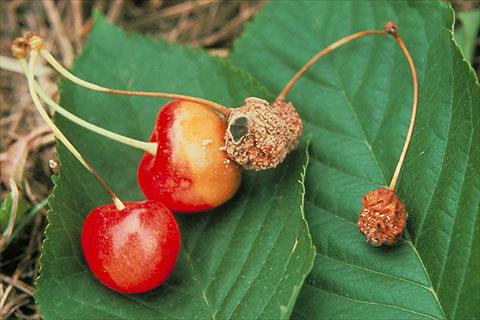Special Indar 2F Fungicide Label Approved on Certain Stone Fruits
We recently received word that a 24 (c) Special Local Needs label for Indar 2F (fenbuconazole) was approved by EPA for use on cherries, peaches, and nectarines (although I realize we don’t have much peach or nectarine in WI). This label will permit growers to apply Indar 2F at a rate of 6-12 fluid ounces per acre (maximum of 48 fluid ounces per acre per season), compared to the regular labeled rate of 6 fluid ounces per acre (maximum of 24 fluid ounces per acre per season). The target disease is brown rot blossom blight and fruit rot of cherries, peaches, and nectarines. While apricot, plum and prune also get brown rot and are listed on the regular Indar 2F label, these crops are not listed on the special label. To use Indar 2F at the higher rates, you must have a copy of the 24 (c) SLN label in your possession at the time of application. Using Indar 2F according to the special label is subject to all use precautions and limitations imposed by the regular label affixed to the product container.

What are the benefits of Indar and why would you consider using the higher rate permitted on the special label? Fenbuconazole, the active ingredient in Indar, is a sterol demethylation inhibitor (DMI, group 3) fungicide that is usually effective in controlling both the blossom blight and fruit rot stages of brown rot, caused by species of the fungus Monilinia, and cherry leaf spot, caused by Blumeriella jaapii. I say “usually highly effective” because where strains of the brown rot or leaf spot pathogens resistant to DMI fungicides are present, the efficacy of Indar decreases as the level of resistance in the fungus increases and as the number of resistant individuals in the fungal population increases. With DMI fungicides, resistance is not “all or nothing,” but rather it is “quantitative.” This means that rather than having an all-out disease control failure, you get some control, but not as good as you would if strains were fully sensitive to the DMI. It also means that if a DMI provides
“some” control at a lower rate, it will generally provide “more” control when applied at a higher rate.
We have strong circumstantial evidence that the leaf spot and brown rot pathogens have developed some level of resistance to the DMI group of fungicides in Door county, where most of the state’s cherries are grown. In particular, in orchards where brown rot disease pressure is high (lots of overwintered brown rot mummies and mild, wet weather during bloom and again as fruit ripen), it is difficult to control this disease with the 6 fluid ounce rate of Indar 2F. In such orchards, a higher rate (i.e., up to 12 fl oz per acre), applied at key times, would provide better control of brown rot and also slow down the rate at which further DMI resistance develops. For further information on chemical control of brown rot on stone fruits, refer to the 2016 Midwest Fruit Pest Management Guide, bulletin A4104 available from the UW-Extension online Learning Store (http://learningstore.uwex.edu/Midwest-Fruit-Pest-Management-Guide-2016-P1785.aspx).
This article was posted in Disease, WFN, Vol. 1-4 and tagged Cherry, Fungicides, Indar 2F Fungicide, Indar 2F Fungicide Label, Patty McManus, stone fruit.
